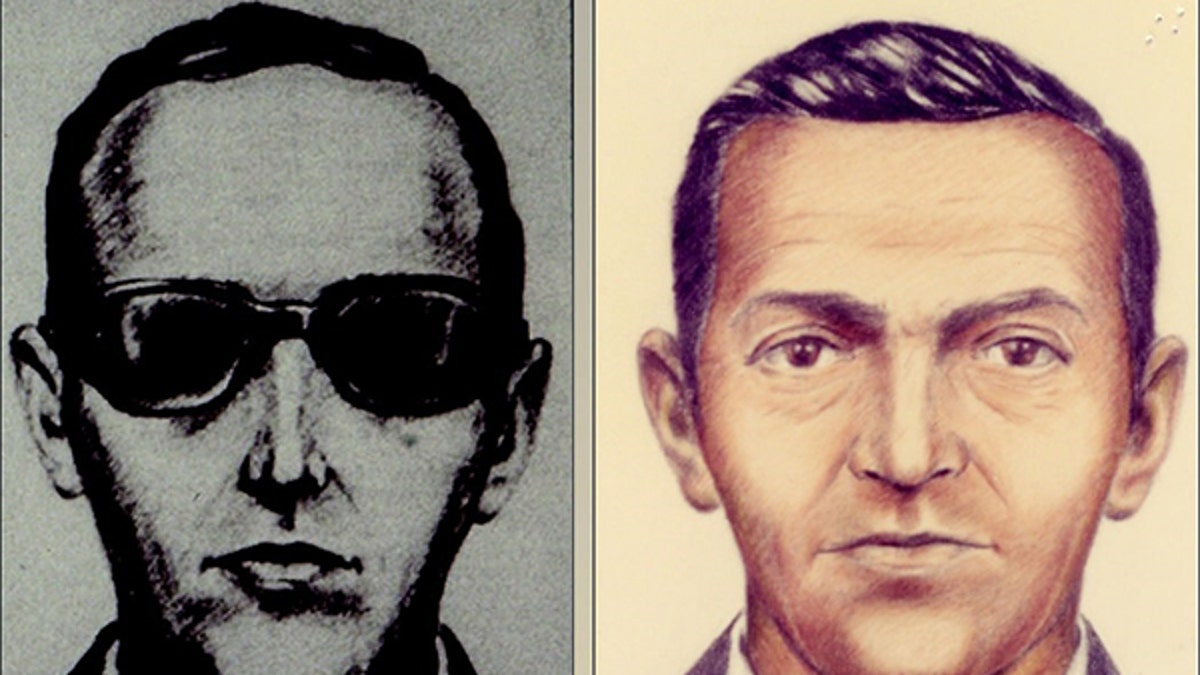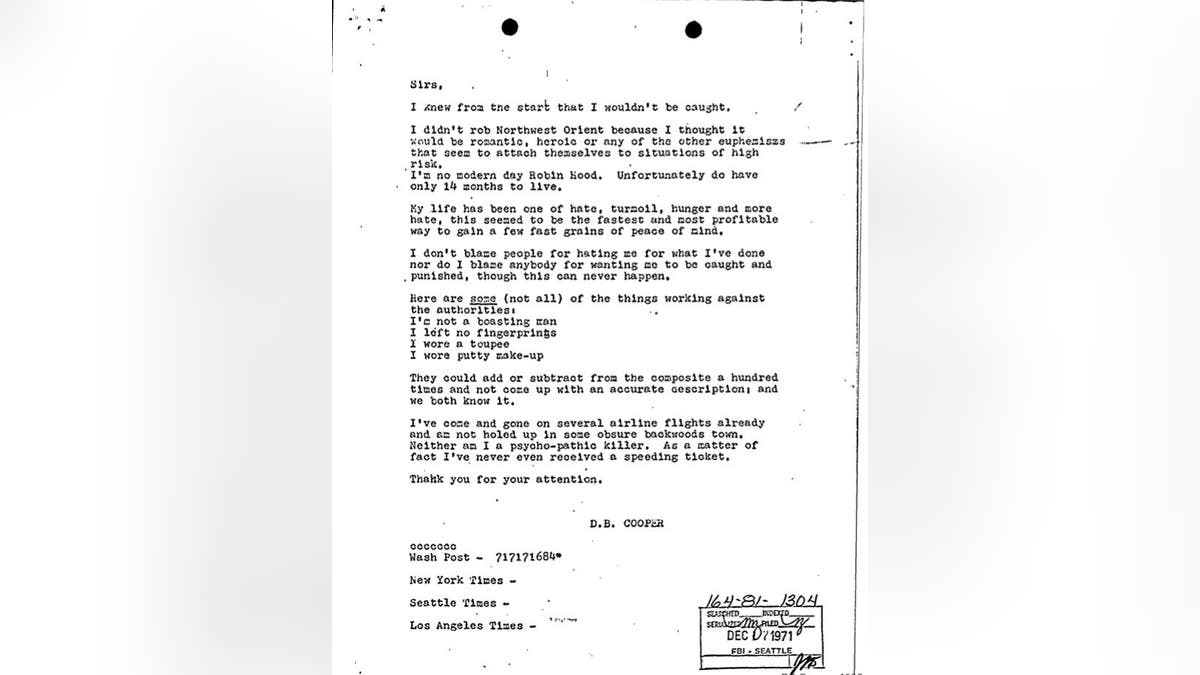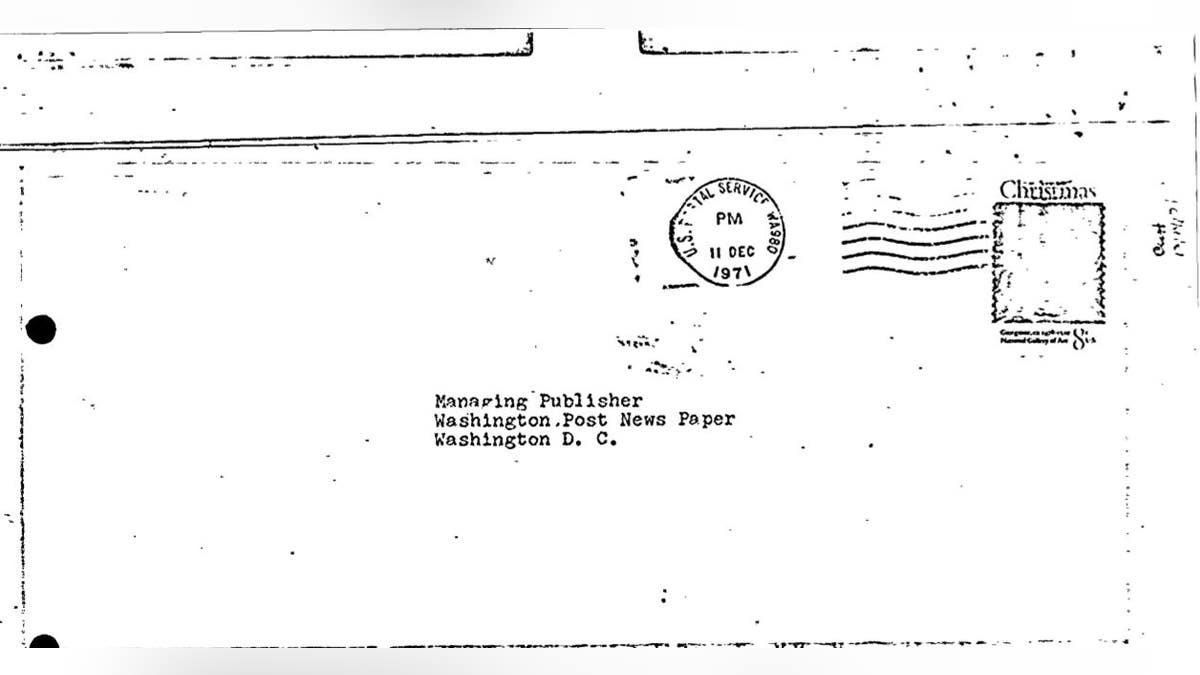
FBI released these sketches after a man named D.B. Cooper hijacked a plane flying from Portland to Seattle on Nov. 24, 1971 and then parachuted out the back door with $200,000, never to be seen again.
Newly released FBI documents pertaining to the D.B. Cooper hijacking case include a letter that may only deepen the mystery surrounding the notorious unsolved crime which marks its 46th anniversary this week.
“I knew from the start that I wouldn’t be caught,” says the undated, typewritten letter from a person claiming to be the man who said he had a bomb and commandeered a Northwest Airlines flight from Portland to Seattle on Nov. 24, 1971. After releasing passengers and crew members, the man then ordered the pilots to fly to Mexico, only to parachute out the back door somewhere over Washington's rugged wooded terrain with $200,000.
“I didn’t rob Northwest Orient because I thought it would be romantic, heroic or any of the other euphemisms that seem to attach themselves to situations of high risk,” he said.
“I’m no modern-day Robin Hood. Unfortunately (I) do have only 14 months to live.”
The carbon-copy letter was turned over to the FBI three weeks after the hijacking by The Washington Post, The New York Times, The Los Angeles Times and the Seattle Times, which were each mailed a copy and published stories about its contents. The letter was in an envelope with a greater Seattle area postmark.
Last month, the FBI released a copy of the letter that was sent to The Post in response to a Freedom of Information Act lawsuit brought by acclaimed D.B. Cooper sleuth Tom Colbert, a Los Angeles TV and film producer. He believes the letter is real.
“We have no doubt it’s from Cooper and the reason is that he cites he left no fingerprints on the plane,” he said. “The reason that’s critical is because it’s absolutely true.”
“There were no prints found in the back of plane,” Colbert said. “They found 11 partial prints that’s all, sides, fingers, tips and palm. But no prints of value were found.”
The FBI wrapped up its D.B. Cooper investigation last year without identifying the hijacker or ruling out the possibility that he could have been killed in the treacherous jump. The FBI says it considered 800 people as suspects. The FBI also never established the authenticity of the letter to the four newspapers, or, for that matter, four other letters that also purported to be from the hijacker. Those letter were sent a few days after the hijacking.
The FBI got its biggest lead in the case in 1980 when a young boy walking along the Columbia River in Washington found a bundle of rotting $20 bills whose serial numbers matched the ransom money serial numbers.
“My life has been one of hate, turmoil, hunger and more hate; this seemed to be the fastest and most profitable way to gain a few fast grains of peace of mind,” the letter said. “I don’t blame people for hating me for what I’ve done nor do I blame anybody for wanting me to be caught and punished, though this can never happen.”
The person wrote that he wouldn’t get caught because he wasn’t a “boasting” man, left no fingerprints, wore a toupee and “wore putty make-up.”
“They could add or subtract from the composite a hundred times and not come up with an accurate description,” the letter said, adding, “and we both know it.”

The person also wrote that he was “not holed up in some obsure (sic) backwoods town” and was not a “psycho-pathic killer.”

“As a matter of fact I’ve never even received a speeding ticket,” the person wrote.
FBI agents in the field apprised FBI Director J. Edgar Hoover of their investigation into the letter, according to other documents the FBI turned over to Colbert along with the letter.
“Efforts were made by (Washington Field Office) to preserve the letter and envelope for latent fingerprints,” read one of the documents, an FBI memo. “However, both were handled by an unknown number of individuals at ‘The Washington Post’ prior to being obtained by WFO.”
“As a matter of fact I’ve never even received a speeding ticket.”
The memo also said that agents couldn’t figure out the significance of the typed number “717171684” opposite the name “Wash Post” in the bottom left corner of the letter.
In another memo, agents in Seattle requested that the FBI lab determine if the paper on which the letter was written could conceivably be from government stock, “noting that it resembles the carbon copy of the airtel material used by the Field Offices.”
Since January, the FBI has released more than 3,000 documents to Colbert, who formed a volunteer team of 40 former law enforcement officials to investigate the hijacking. The FBI said in court papers that it has more than 71,000 documents that may be responsive to Colbert’s lawsuit.
Colbert and his team believe D.B. Cooper is an individual named Robert Rackstraw who flew helicopters in the Vietnam War and is now 73 and living in the San Diego area.
In March, Rackstraw sent the judge presiding over Colbert’s FOIA lawsuit a rambling 9-page letter that the judge took to be a motion to intervene in the case. In his letter Rackstraw said that he was not D. B. Cooper and accused Colbert of ruining his life.
The judge responded to the letter by issuing a ruling that rejected Rackstraw's motion.
In July, Rackstraw sent another letter to the court in which he again said he was not the hijacker.





















